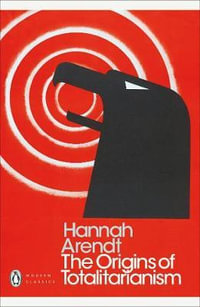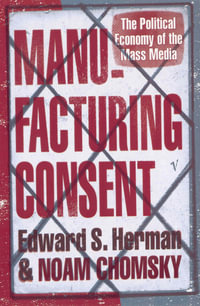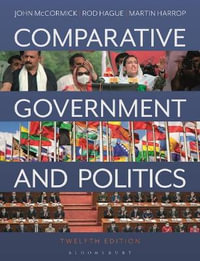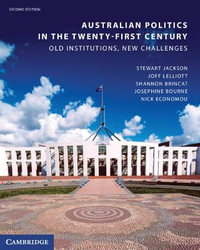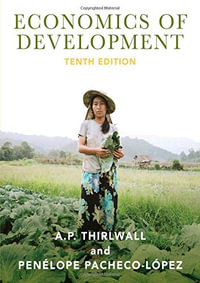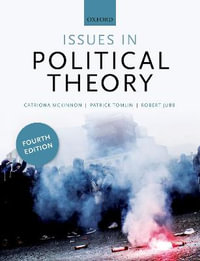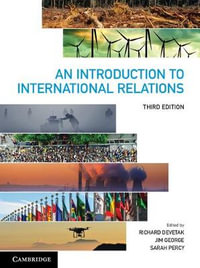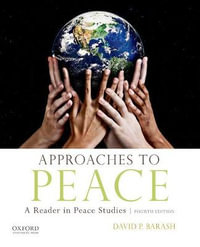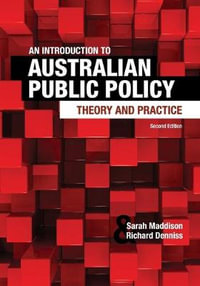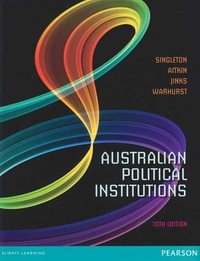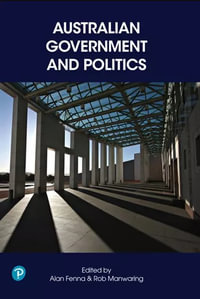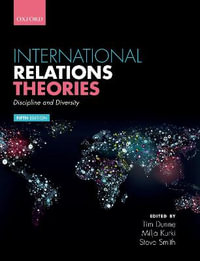
Introduction to Global Politics
4th Edition
By: Richard W. Mansbach, Ellen Pirro
Paperback | 14 June 2023 | Edition Number 4
At a Glance
578 Pages
25.5 x 22.5 x 2.5
Paperback
RRP $101.00
$87.25
14%OFF
or 4 interest-free payments of $21.81 with
orIntroduction to Global Politics, Fourth Edition, is an accessible, comprehensive, and well-written introductory textbook which emphasizes the evolution of major global issues from the past to the present. By integrating theory and political practice at individual, state, and global levels, students are introduced to key developments in global politics, helping them make sense of major trends that are shaping our world.
This completely revised and updated edition includes new material on:
- the dramatic shift in US policies under President Donald Trump and the post-Trump moves to redo the global scene
- the coronavirus pandemic and its impact around the world
- Brexit, and its consequences for the European Union
- the rise of China and Russia in the international order
- technological developments in weaponry and the militarization of outer space
- the growing importance of the politics of identity, the environment, nationalism and populism while retaining much of the structure and many of the features of past editions, including a revised range of faculty and student aids- a test bank, flashcards, glossary, web links, PowerPoint slides, chapter outlines, suggested video clips, map exercises, cultural references, and boxed features
Stimulating and provocative, the book is designed to appeal to students and instructors interested in international relations as a broadly defined, multidisciplinary subject encompassing politics, history, economics, military science, psychology, sociology, anthropology, and philosophy.
About the AuthorsRichard W. Mansbach, Professor of Political Science at Iowa State University, USA, has authored or coauthored over 20 books, written numerous articles and book chapters, and received numerous awards.
Ellen B. Pirro, Associate Teaching Professor at Iowa State University, has coauthored or edited a number of books in international relation and European politics, as well as numerous articles and book chapters.
Half Title Page
Endorsement Page
Title Page
Copyright Page
Dedication
Table of Contents
List of figures
List of tables
List of maps
About the authors
Preface
Prologue
Global change
Global continuity and the importance of history
Threats and opportunities
The plan of the book
Part I Theory and global politics
1 Theoretical approaches to global politics
What is theory and why do we need it?
Many theories, many meanings
Levels of analysis
The individual
The unit
The global system
Making sense of a complex world: theory and global politics
The great debates: an introduction to different worldviews
Marxism and critical theory
Feminist international relations
Conclusion
Student activities
Map analysis
Cultural materials
Further reading
Notes
Part II The past as prologue to the present
2 The evolution of the interstate system
The emergence of the European interstate system
The transition from Europe’s Middle Ages
Machiavelli’s world: Italy’s city-states
On the road to sovereignty
From dynastic to popular sovereignty
China: the Confucian empire
Islam’s founding and expansion
The Caliphate
Cracks in the Islamic community
Islam and Christendom: the Crusades
The Ottoman Empire – Islam versus Europe
Conclusion
Student activities
Map analysis
Cultural materials
Further reading
Notes
3 The world wars
Events leading to the Great War
German unification and Europe’s diplomatic revolution
Arms races, nationalism, and the Balkan imbroglio
Crisis diplomacy
The final descent to war
Explaining the outbreak of World War One
Individual-level explanations
Unit-level explanations
Global system-level explanations
The Peace of Versailles
Woodrow Wilson and the Fourteen Points
Versailles and the principle of national self-determination
The League of Nations and the failure of collective security
Origins and controversies
The League’s record in securing peace
Appeasement and its consequences
On the road to Pearl Harbor
Explaining the outbreak of World War Two
Individual-level explanations
Unit-level explanations
Global system-level explanations
Conclusion
Student activities
Map analysis
Cultural materials
Further reading
Notes
4 The Cold War
Explaining the origins of the Cold War
Individual-level explanations: Stalin, Churchill, Truman, and Mao
Unit-level explanations
Global system-level explanations
Theory and the onset of the Cold War
The Cold War spreads and deepens
Containment
Militarizing the Cold War
The Cold War winds down
The end of the Cold War
Resurgent Russia
Conclusion
Student activities
Map analysis
Cultural materials
Further reading
Notes
5 Decolonization and the global South
Europe’s empires
The early conquerors: Spain and Portugal
Holland
France and Great Britain
Late imperialism
The decolonization of Asia and Africa
India: from colony to great power
Decolonization in Africa
The politics of nonalignment, nation-building, and economic development
Nonalignment
Modernization and postcolonial theory
Failed and fragile states
Other fragile states
The BRICS, emerging markets, and global governance
Conclusion
Student activities
Cultural materials
Further reading
Notes
6 Globalization: The new frontier
Features of globalization
The spread of communication and information technologies
The declining importance of territory
The spread of knowledge and skills and the participation explosion
Capitalism and the emergence of a global market
The privatization of public functions
The spread of global culture
The spread of democratic norms
The emergence of global civil society
Diffusion of global power
The changing nature of security
The growing importance of nonstate identities and loyalties
The historical roots of globalization
Competing perspectives on globalization
The globalization debate
The anti-globalizers
The pro-globalizers
The state in decline?
The limits of sovereignty
Conclusion
Student activities
Map exercise
Cultural materials
Further reading
Notes
Part III Living dangerously in a dangerous world
7 Great issues in contemporary global politics
The nuclear proliferation regime
Dangers of horizontal proliferation
India and Pakistan
North Korea and Iran
China and the United States: a new bipolarity?
From hostility to engagement
Strategic partners or strategic rivals?
Taiwan
Military rivalry
Sino-American policies interests in North Korea and Iran
China and Human Rights
Israel and Palestine
Palestine after World War One
Israel’s wars with its Arab neighbors
From crisis to crisis: the Yom Kippur War, Lebanon, and Camp David
Oslo and the intifadas
The Gaza imbroglio
Impediments to peace
Several factors stand in the way of a lasting solution to the conflict
US-Israeli relations: from Bush to Biden
Militant Islam: the “Green Menace”
Fundamentalism
The Iranian revolution and its consequences
Afghanistan and Iraq
The Afghan background
The Soviet invasion and Islamic resistance
The Afghan War
The Iraq dimension
The changing Middle East
Conclusion
Student activities
Cultural materials
Further reading
Notes
8 Power in global politics and the causes of war
The quest for power and influence
The purposes of power
The elements of power
The causes of interstate war
The individual level: human nature and psychology
The unit level: foreign policy and war
The global system level and war
Controversy: polarity
The causes of intrastate war
Individual-level explanations
Unit-level explanations
The fallout of interstate conflict: the global system level of analysis
Managing intrastate war
Foreign intervention
Power-sharing
Physical separation
Conclusion
Student activities
Map analysis
Cultural materials
Further reading
Notes
9 Technology and the changing face of warfare
War as an extension of politics
Karl Maria von Clausewitz, “What Is War?”
On the road to absolute war: the world wars
Technology and interstate war
Technology and World War One
The tank
Technology and World War Two
The Dresden bombing
Technology and the Cold War standoff
Strategies in a nuclear age
Nuclear deterrence in the Cold War
Nuclear deterrence today
Irregular warfare
Guerrillas, anti-colonial struggles, and revolutionary war
Global terrorism
Al Qaeda and Islamic terrorism
America’s War on Terror: the rise of the Islamic State (ISIS)
Technology in modern conflicts and wars
Smart weapons
Cyberwar
Conclusion
Student activities
Map analysis
Cultural materials
Further reading
Notes
10 Managing conflict: international law and international and transnational organization
The “law of nations”
Sources and evolution of international law
The just war tradition
International organizations
The United Nations
Early expectations
UN organs
The UN and the maintenance of peace
The UN and the future
Regional international organizations
The European Union (EU)
European (dis)union? Brexit
Other regional organizations
Conclusion
Student activities
Map analysis
Cultural materials
Further reading
Notes
Part IV Global issues
11 Identity politics: nationalism, religion, and ethnicity
Multiple identities
Conflicting identities and national (dis)unity
Divided loyalties?
The “fifth column”: “We” versus “them” in global politics
Identities and technological change
Manipulating identities
Virgil’s The Aeneid
Nationalism
The bases of nationalism
Nations, states, and nation-states
The brutal break-up of Yugoslavia
Nationalism in the Balkan Wars
Religious identities
Ethnic identities
Approaches to culture
A clash of civilizations?
Alternative cultural models
Conclusion
Student activities
Map exercise
Cultural materials
Further reading
Notes
12 International political economy
The beginnings of a global economy
Theories of political economy
Mercantilism
Economic liberalism
Marxism
The Great Depression
The Depression begins
The Depression spreads
The Bretton Woods institutions
The International Monetary Fund (IMF)
The World Bank
The General Agreement on Tariffs and Trade (GATT)/ World Trade Organization (WTO)
Hegemonic stability theory
Transnational corporations: engines of global capitalism
The global reach of TNCs
Criticisms of TNCs
Reforming TNCs
States and markets
The Asian contagion
The American contagion
China’s economic model
Conclusion
Student activities
Map analysis
Cultural materials
Further reading
Notes
13 Human rights: the individual in global politics
The Holocaust and the Genocide Convention
The Nuremberg precedent and the evolution of international criminal tribunals
The Nuremberg and Japanese trials
Ethnic cleansing in Yugoslavia
The Rwandan genocide and civil war in Sierra Leone
Cambodia’s “killing fields”
The Uighur genocide
The International Criminal Court
The doctrine of universal jurisdiction
Individual rights under international law
Sources of human rights
The elaboration of human rights
Explanations of human-rights abuses
Amnesty International
Women’s rights as human rights
Gender (in)equality
Violence against women
Reproductive independence
Should women have equal rights…everywhere?
Conclusion
Student activities
Map exercise
Cultural materials
Further reading
Notes
14 Human security
The concept of human security
Poverty and economic development
Global dimensions of poverty
International institutions and global poverty
Debt relief
Foreign aid and investment
Access to markets
Transnational crime
Responses to drug trafficking
Money laundering
The arms trade
The global arms market
The black market in weapons of mass destruction
Responses to the global arms trade
The global movement of persons
Refugees
Undocumented aliens
Immigration and demography
Human trafficking
Globalized diseases
Epidemics and pandemics
Coronavirus COVID-19 pandemic
Doctors Without Borders
Medical tourism
Conclusion
Student activities
Cultural materials
Further reading
Notes
15 The environment: a global collective good
Collective goods and collective fates
Climate change
Population and environment
Population trends
Increasing conflict?
Defusing the population bomb
Deteriorating global ecology
China
Global energy politics
Fossil fuels and global warming
Too little food
Vanishing forests and encroaching deserts
Water: dying seas and drying wells
Environmental IGOs
Greenpeace
Conclusion
Student activities
Map exercise
Cultural materials
Further reading
Notes
Part V Epilogue
Epilogue: A future dimly seen
Alternative futures
A globalized world
A world of liberal institutions
A world in chaos
A realist world
Conclusion: an uncertain future
Student activities
Cultural materials
Further reading
Notes
Glossary of key terms
Index
ISBN: 9781032020501
ISBN-10: 1032020504
Published: 14th June 2023
Format: Paperback
Language: English
Number of Pages: 578
Audience: College, Tertiary and University
Publisher: Taylor & Francis Ltd
Country of Publication: GB
Edition Number: 4
Dimensions (cm): 25.5 x 22.5 x 2.5
Weight (kg): 1.46
Shipping
| Standard Shipping | Express Shipping | |
|---|---|---|
| Metro postcodes: | $9.99 | $14.95 |
| Regional postcodes: | $9.99 | $14.95 |
| Rural postcodes: | $9.99 | $14.95 |
How to return your order
At Booktopia, we offer hassle-free returns in accordance with our returns policy. If you wish to return an item, please get in touch with Booktopia Customer Care.
Additional postage charges may be applicable.
Defective items
If there is a problem with any of the items received for your order then the Booktopia Customer Care team is ready to assist you.
For more info please visit our Help Centre.
You Can Find This Book In
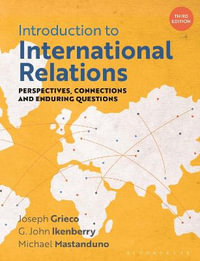
Introduction to International Relations
3rd Edition - Perspectives, Connections and Enduring Questions
Paperback
RRP $102.95
$85.90
OFF
This product is categorised by
- Non-FictionHistory
- Non-FictionPolitics & GovernmentPolitical ActivismArmed Conflicts
- Non-FictionWarfare & Defence
- Non-FictionEconomicsPolitical Economy
- Non-FictionPolitics & GovernmentInternational RelationsDiplomacy
- Non-FictionSociety & CultureSocial Issues & ProcessesGlobalisation
- Text BooksHigher Education & Vocational TextbooksPolitics Higher Education Textbooks
